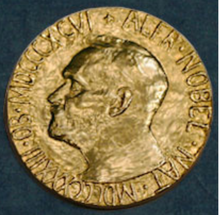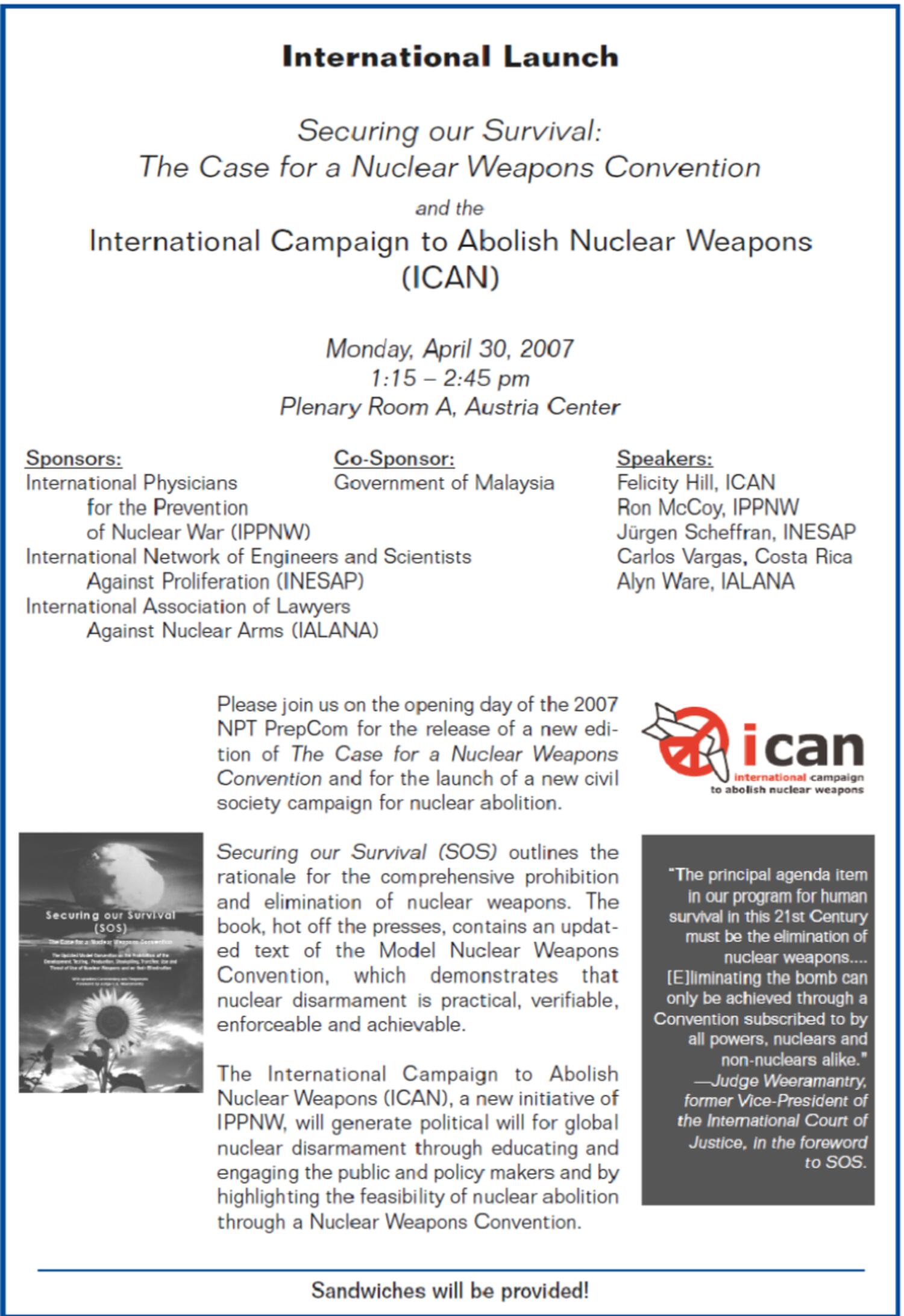
by Jürgen Scheffran
November 13, 2017
In October of 2017, the Nobel Peace Prize was awarded to the International Campaign to Abolish Nuclear Weapons (ICAN), “for its work to draw attention to the catastrophic humanitarian consequences of any use of nuclear weapons and for its ground-breaking efforts to achieve a treaty-based prohibition of such weapons”. Jürgen Scheffran, Professor of Geography at the University of Hamburg and former Senior Research Scientist at ACDIS (2004–2009), contributed the following commentary.
On September 20, 2017, the United Nations opened for a treaty to ban nuclear weapons that will enter into force after ratification by 50 countries. After decades of arms races and little or no recent progress on nuclear disarmament, many countries no longer want to accept the special status of the nuclear-weapon states. The treaty bans the last weapon of mass destruction, following the ban on biological and chemical weapons. However, the treaty does not implement the disarmament process to the nuclear-weapon-free world, and the nuclear-weapon states and their allies are not yet involved.
This agreement is the success of a long-standing movement for the prohibition and abolition of nuclear weapons after the end of the Cold War. In 1993 the IANUS research group in Darmstadt, Germany initiated the International Network of Engineers and Scientists Against Proliferation (INESAP) which proposed a treaty for the prohibition and elimination of all nuclear weapons, a Nuclear Weapons Convention (NWC). INESAP coordinated a study by more than 50 scientists from 17 countries on a nuclear-weapons-free world. The study was presented during a symposium at the Review and Extension Conference of the Nuclear Non-Proliferation Treaty (NPT) in April 1995, on the occasion of the foundation of the global network Abolition 2000.1 A group of experts drafted a Model NWC, which was presented to the NPT Conference in April 1997 in New York and submitted by Costa Rica to the United Nations. A revised version was presented by the drafting team (including the present author) on April 30, 2007, at the NPT conference in Vienna, on the occasion of the foundation of the International Campaign to Abolish Nuclear Weapons (ICAN).2
The majority of states joined this initiative since 1996 and then voted for a resolution of the UN General Assembly (A/RES/51/45) calling for multilateral negotiations on the NWC. In October of 2008, UN Secretary-General Ban Ki-moon presented a five-point plan for nuclear disarmament, based on a “framework of separate, mutually reinforcing instruments” or “negotiating a nuclear-weapons convention”.3 New momentum has been generated since 2010 through closer cooperation between states and civil society on the humanitarian dimensions of nuclear weapons. On December 23, 2016, the UN General Assembly decided to hold a conference to negotiate a treaty for the prohibition of nuclear weapons leading to their elimination. Led by Costa Rica, the treaty was finalized expeditiously and adopted in New York on 7 July 2017 by 122 states, not including the nuclear-weapon states,4 the NATO allies, and other states under the U.S. “nuclear umbrella” (such as Japan, South Korea, and Australia).
The Ban Treaty was celebrated as a breakthrough to outlaw and stigmatize nuclear weapons. Signatories will commit not to develop, test, produce, manufacture, or otherwise acquire, possess, stockpile, deploy, transfer, use, or threaten to use nuclear weapons or other nuclear explosive devices. In addition, the treaty also defines the framework conditions for a verification regime, based on safeguards by the International Atomic Energy Agency (IAEA), against the military use of nuclear energy in non-nuclear-weapon states, which can be extended to nuclear-weapon states. The agreement also addresses better protection, assistance, and environmental rehabilitation of victims of nuclear weapons use and testing. Other provisions concern the preamble, reporting obligations, costs, international conferences and potential authorities, dispute resolution, and entry into force, as well as future inclusion of other states and potential obligations for nuclear abolition.
While the globalized world order is under pressure and creates new nuclear risks (such as tensions in Korea), many countries rebel against the position of the countries that have nuclear weapons. Apparently, the United Nations can act on important issues, create international law, and establish new coalitions against the dominant power structure. Although the Ban Treaty does not eliminate nuclear weapons, it has an important symbolic significance and puts pressure on the nuclear-weapon states. It can serve as a framework for nuclear disarmament negotiations, connecting further steps towards a Nuclear Weapons Convention to implement a nuclear-weapon-free world.5 Such an approach put down its roots twenty years ago in the incremental-comprehensive approach of the Model NWC.
The persistent activities of civil society for the abolition of nuclear weapons were awarded the 2017 Nobel Peace Price to ICAN “for its work to draw attention to the catastrophic humanitarian consequences of any use of nuclear weapons and for its ground-breaking efforts to achieve a treaty-based prohibition of such weapons”.6
Jürgen Scheffran is a physicist and professor of geography at the University of Hamburg, Germany. He worked with ACDIS at the University of Illinois between 2004 and 2009, was a co-founder of INESAP at IANUS, and one of the drafters of the Model Nuclear Weapons Convention. This piece is partly based on an article published in the journal Wissenschaft & Frieden (Science & Peace), http://wissenschaft-und-frieden.de/seite.php?artikelID=2230. Email: juergen.scheffran@uni-hamburg.de.
References
1. INESAP (ed.) (1995) Beyond the NPT – A Nuclear-Weapon-Free World. INESAP Study Group Report, New York/Darmstadt: INESAP (http://www.inesap.org/book/beyond-npt-nuclear-weapon-free-world).
2. The 2007 Model NWC is published in: Datan M, Hill F, Scheffran J, Ware A, Kalinowski M, Sidel V (2007) Securing Our Survival – The Case for a Nuclear Weapons Convention. IPPNW, IALANA, INESAP, Cambridge, MA (www.researchgate.net/publication/280733545_Securing_Our_Survival_The_Case_for_a_Nuclear_Weapons_Convention). Costa Rica submitted the Model NWC as a Working Paper to the UN: https://documents-dds-ny.un.org/doc/UNDOC/GEN/N07/327/68/PDF/N0732768.pdf?.
3. United Nations Office for Disarmament Affairs, The Secretary-General’s five point proposal on nuclear disarmament – “The United Nations and security in a nuclear-weapon-free world”. 24 October 2008 https://www.un.org/disarmament/wmd/nuclear/sg5point.
4. United Nations Office for Disarmament Affairs, Treaty adopted on 7 July 2017 – United Nations Conference to Negotiate a Legally Binding Instrument to Prohibit Nuclear Weapons, Leading Towards their Total Elimination. https://www.un.org/disarmament/ptnw.
5. Scheffran J (2010) The Nuclear Weapons Convention as a Process – Umbrella Negotiations as a Framework for a Nuclear-Weapon-Free World. Paper presented at: Middle Powers Initiative, Atlanta, Jan. 20-22, 2010. http://www.baselpeaceoffice.org/sites/default/files/imce/oewg/scheffran_the_nwc_as_a_process.pdf. Loretz J, Scheffran J, Ware A, Wright T (2010) A Nuclear Weapons Convention – Framework for a Nuclear Weapon Free World. In: Acheson R (ed.) Beyond arms control. New York: WILPF, pp. 181-187.
6. https://www.nobelprize.org/nobel_prizes/peace/laureates/2017; http://www.icanw.org.
